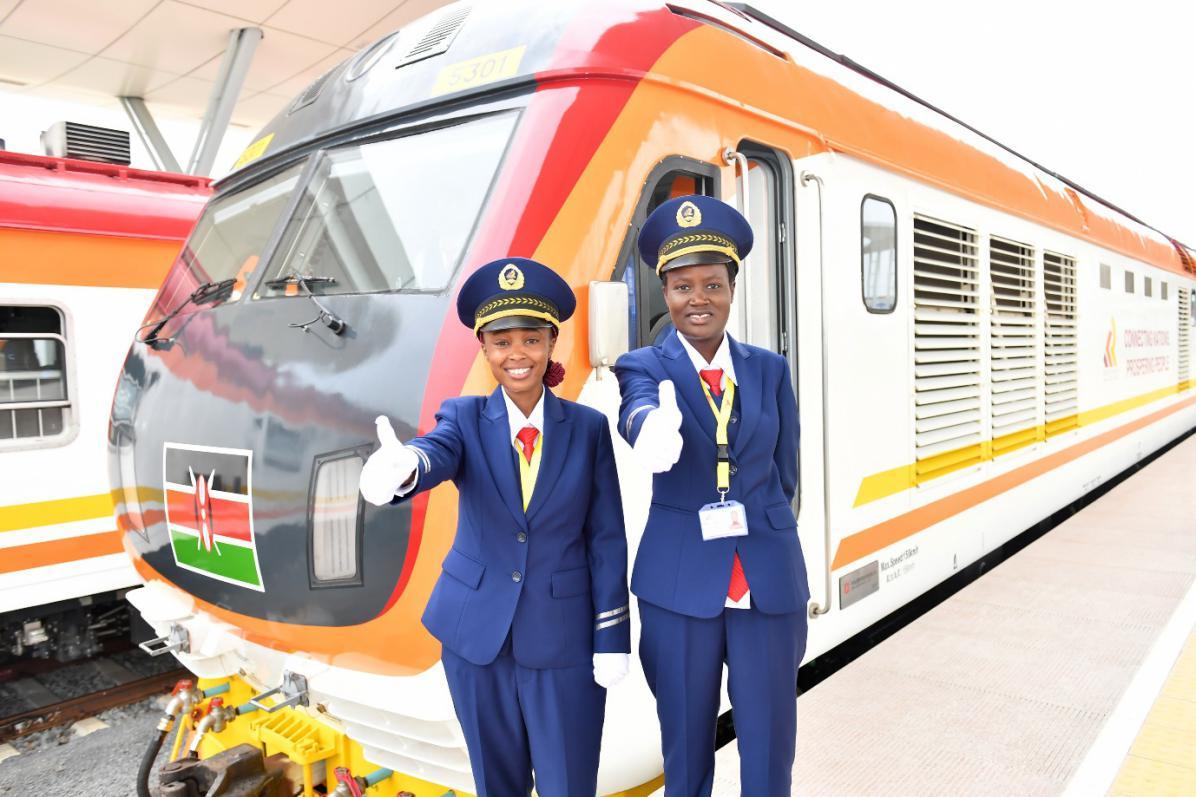
The first train drivers Concilia Owire (right) and her colleague give their thumbs-up before departure, wishing the journey success at Mombasa West Station on the Mombasa-Nairobi Railway in Kenya, May 31, 2017. (Xinhua)
BEIJING, April 24 (Xinhua) -- A train with a stunningly modern look whizzes past a grove of acacia trees as the golden sun sets on a boundless East African savanna. A giraffe's silhouette stuns as passengers peer in awe out the window at the view.
A special report released by CNN Travel in October 2018 listed 20 activities that American tourists deem the most worthwhile while visiting Kenya. "Traveling on the newly-built Mombasa-Nairobi Railway" ranked fifth.
But the CNN report failed to mention one key detail: the new railway connecting the Kenyan capital of Nairobi with Mombasa, the country's second-largest city and main port, was not a rebuild of a century-old British-built railway.
This century-old "meter-gage" railway was put into use by the British Empire in 1901. With a narrow track gage of 1,000 millimeters, it was designed to run through the barren lands of Kenya as a gateway to Uganda's rich resources. At that time, the country of "Kenya" did not yet exist and was known as the British-ruled East Africa Protectorate. For more than a century, this railway to Uganda was the only one in Kenya. But during that time, the aging and mottled "meter-gage" railway fell far behind the times.
Today, a new railway built by China Communications Construction (CCC) runs almost parallel to the old British-made track, with brand-new high-speed trains running back and forth every day. Thanks to the CCC-built Mombasa-Nairobi Standard Gage Railway (or the Mombasa-Nairobi Railway for short), which opened to traffic in May 2017, the trip from Mombasa to Nairobi has been cut from 10 hours to just four and a half hours.
Women take control
In her smart blue uniform, 24-year-old Concilia Owire sits in the train driver cab with a big smile on her face as she waits for departure. She is one of the eight women who became Kenya's first-ever female train drivers.
"I hope I can challenge common gender stereotypes through my efforts. I will prove that women also qualify for jobs such as train drivers," Owire said. These train-driving Kenyan women are already considered national treasures and a symbol of the advancement of women's equality in Africa. "Girls, you made history! It is great!" one social media user wrote.
At the beginning of 2017, Owire and her colleagues completed 50 days of systematic and professional training at Baoji Railway Technician College in northwest China's Shaanxi province. There, they became familiar with the structure of China-made diesel locomotives and their operational principles, as well as standard driving, overhaul and maintenance procedures.
Back in Kenya, Owire and her colleagues now train with Chinese instructors half an hour before the railway's trains depart from Nairobi at 8.00am. They get up two to three hours before departure and arrive at the training ground at the Nairobi terminal of the railway at about 7.30 am. There is usually only time for a one-hour break in the afternoon and the drivers usually work a 12-hour shift in total.
"I find it very challenging to train these Kenyan women as they have a lack of experience," says Owire's Chinese instructor Tu Zhuxin, who trained Chinese passenger train drivers for 10 years before moving overseas to continue his work. "These hardworking and highly motivated women are willing to endure hardships; they never complain," he said, adding that their enthusiasm to learn is highly impressive.
As a hallmark of the China-Kenya friendship, Owire hopes the much-anticipated Mombasa-Nairobi Railway will bring positive changes to her family and Kenya at large.
A new era of development
The nearly 480-kilometer-long Mombasa-Nairobi Railway connects Kenya's major cities, transforming the country's freight and passenger transport systems, and bringing scenes of bustling platforms filled with keen travelers. And this is all reflected in the statistics.
By the end of 2018, more than 2 million passengers had traveled on the Mombasa-Nairobi Railway, with the booking rates during weekends and holidays reaching 100 percent. It's safe to say that tickets are selling like hotcakes.
At the moment, four passenger trains and 18 freight trains operate daily along the railway. And since the railway project started, it has provided around 50,000 jobs in total for locals.
Christmas 2018 saw Kenyan President Uhuru Kenyatta experience first-hand the "Kenyan version of the Chinese Spring Festival travel rush" on the railway.
"Earlier today, I took the SGR train from Nairobi to Mombasa, during which I met and interacted with fellow commuters who shared their interesting experiences about the service. I am glad that the SGR train services have enhanced travel for Wananchi between the two cities," the president later posted on social media.
Making this railway experience unmissable when traveling across Kenya, high-speed trains pass through two famous national parks, namely Nairobi National Park and Tsavo National Park, the country's largest wildlife sanctuary and the home of many African animal species including the world's tallest giraffes.
The railway even provides convenience and a safe environment for these animals, with viaducts specially built so giraffes don't bang their heads when walking underneath the railway. Nine such structures have been built in Tsavo National Park alone.
Over time, trains have become an intrinsic part of Kenyan culture. "Kenya is a country born on rails," says the brochure of a museum in Nairobi, which could explain why Kenyan media describes the railway as 'a project of the century.'
More than 100 years ago, the British Empire wouldn't have expected Kenya to gain independence and revive itself. Fast forward to 2019 and a brand-new modern railway lies besides its old, run-down predecessor, fulfilling Kenya's dream of heralding a new era of transportation and a new stage of development. (Contributed by Ding Lei and Jin Zheng, edited by Qiu Jun, Niu Huizhe)




 A single purchase
A single purchase









